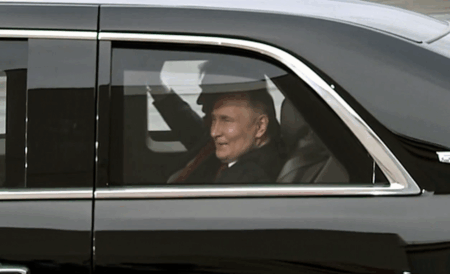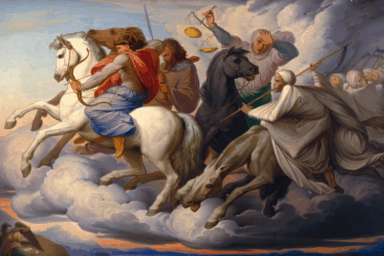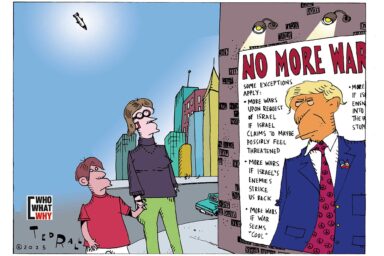A Nobel Prize and shades of Yalta?
|
Listen To This Story
|
Before the US 2016 election, the word on the street in Moscow was that Donald Trump was America’s “useful idiot,” a derogatory term referring to naive supporters of a political agenda that they do not really understand.
There was no question that the Kremlin preferred Trump’s self-delusional universe to Hillary Clinton’s firm grasp of reality. Whatever Clinton’s shortcomings as a presidential candidate, her brief turn as secretary of state proved that she was a sharp negotiator. Trump, on the other hand, looked like a sure-bet patsy. The KGB had already spent considerable time and effort getting to know him.
Trump’s recent meeting with Vladimir Putin at the Joint Base Elmendorf-Richardson airbase in Alaska — where Trump invited Putin to ride with him in the presidential limousine nicknamed The Beast — can be seen as the ultimate result of that effort.
Trump likes to see himself as a master dealmaker, but, in fact, his approach is usually crudely, and often personally, transactional — applying a mixture of charm and intimidation to score a sizable financial payoff. In contrast, before he began his political career, Putin was a KGB colonel. A primary focus of intelligence agents is the seduction and manipulation of potential assets. To a former Soviet agent/handler, Trump must have looked like a tasty between-meal snack — an emotionally insecure and vulnerable target who could easily be manipulated into what amounted to a Manchurian candidate.
Post-communist Russia is no longer inherently an enemy of the United States, but it is not a friend either. It is, in fact, a global competitor. In a highly transactional — some would say zero-sum — world, the loss of US influence and power creates space for Russia to gain. From Moscow’s point of view, global cooperation and the largely American-crafted international financial order look very much like euphemisms for American dominance.
It is not hard, therefore, to see why the Kremlin thought it worth investing heavily in targeted advertising and social media efforts to promote Trump as an American leader, who could in the future be “turned” into a supporter of Russian initiatives.
An FBI investigation following the 2016 election concluded that, although the Russians had engaged in cyber trickery on social media and made a substantial investment in advertising on Facebook and other platforms, there was no evidence that Russian propaganda persuaded enough Americans to vote for Trump to alter the election’s outcome.
That was then. The real payoff to Moscow’s initial investment may have come during the Alaska meeting with Putin.

Leading an administration stocked with sycophantic MAGA followers, Trump has been set free to pursue policies close to his heart. One focus has been on ending the armed conflict between Russia and Ukraine. Trump has always hoped to do business in Russia, and lately he has begun obsessing about possibly winning the Nobel Peace Prize, which in his mind at least might put him at the same level as Barack Obama, who won the prize without even asking for it. In Trump’s thinking, peace in Ukraine might just do the trick.
From Putin’s point of view, Trump’s ego-driven craving is America’s weak point to be ruthlessly exploited in what amounts to a global chess game. Putin’s own obsession has been to recreate the old Soviet Empire that collapsed in the early 1990s with the demise of the communist state.
In fact, that empire was the result of several centuries of expansive colonialism, beginning under Russian czars who were determined to extend Moscow’s control over neighboring countries. That colonial effort left pockets of ethnic Russians distributed throughout Central Asia. As these countries sought to gain independence in the 1990s, isolated ethnic Russian expatriates suddenly found themselves an endangered species. A notable example is Crimea, which officially belongs to Ukraine, but whose population is more than 60 percent ethnic Russian.
Apart from Crimea, Ukraine itself has turned out to be a special case. A relatively large country geographically, and once part of the Soviet Union, it now occupies critical territory between Russia and the rest of Europe.
During the Cold War, Russia tried to deploy intermediate-range nuclear missiles along Ukraine’s frontier. The missiles would have given Moscow the capability of striking at major European cities with less than a 10-minute warning. That in turn would have given the Kremlin the power it needed to bully Europeans into conceding to Russian policy demands.
The US countered by deploying its own set of missiles that effectively neutralized the Russian threat. Both sides eventually stood down and, in 1987, signed the Intermediate-Range Nuclear Forces (INF) Treaty, which eliminated the missiles on both sides. The US, under Trump, withdrew from the INF Treaty in 2019, leaving it in limbo; Russia withdrew earlier this month.
Ukraine, it turned out, was advancing economically much faster than Putin’s oligarchy in Russia. Although Russia’s economy is 10 times larger, Ukraine’s growth rate from 2015 to 2020 was 70.8 percent, while Russia’s growth rate during the same period was 8.8 percent. Russia’s economic expansion was primarily in service industries; Ukraine’s expansion was in technology.
Not surprisingly, Ukraine found itself naturally drawn to economically successful Western Europe. After Russia annexed Crimea — ostensibly to defend Russian nationals living there — Ukraine’s economy was cut in half.
Ukraine naturally began building up its border defenses, hoping to prevent further onslaughts from Russian forces. The result was a string of fortress installations along the frontier that separates eastern Donbas from the rest of Ukraine. Having thus far found it extremely difficult to break through that line of defense, Putin has resorted to recruiting soldiers from Russia’s Siberian gulag and even hiring mercenary troops from North Korea to make up for the punishing losses Russian troops have suffered.
While Russia’s military has gained some small pieces of ground, at great cost in human lives, Putin is still far from asserting control over his significantly smaller neighbor.
Anywhere from 70 to 80 percent of Russian casualties in the fighting of late have been inflicted by relatively inexpensive drones that Ukraine manufactures by the thousands. The Ukrainians may have a smaller population than Russia, but they are well educated and fiercely determined to fight for their independence. With the help of military supplies from the United States and its European allies, they have kept Putin from gaining the quick and bloodless victory that he promised when his forces launched an all-out invasion in February 2022.
Putin has effectively boxed himself in, and there is no clear exit strategy. Unless he can play his Trump card by abetting the American president’s dream of receiving that ego-massaging Nobel Prize.
Putin’s concern these days is that after the carnage he has wreaked on Ukraine, he has turned what was once a somewhat friendly neighboring state into a passionate enemy that he has failed to dominate. Putin has effectively boxed himself in, and there is no clear exit strategy.
Unless he can play his Trump card by abetting the American president’s dream of receiving that ego-massaging Nobel Prize.
Peace in Ukraine might just make the dream a reality and be a win-win for Russia and Donald J. Trump — if, and only if, Ukrainian President Volodymyr Zelenskyy can be persuaded to quaff a poisoned cocktail of suicidal diplomatic concessions.
Trump, the self-proclaimed master negotiator, announced on his way to Alaska that Putin would have to accept an immediate ceasefire or face serious “consequences.” After their face-to-face encounter, Trump apparently chose to cave to Putin’s insistence on continuing peace negotiations without a ceasefire. And with no “consequences” anywhere in sight.
Putin knows that if he can get Zelenskyy to surrender Kyiv’s fortified line of defense, the details of any peace agreement will be rendered effectively irrelevant. After all, Ukraine received Western guarantees that its independence would be assured when it agreed to give up its arsenal of Soviet-era nuclear weapons in 1994. And then, what did the West, including the United States, do when Putin invaded Ukraine eight years after seizing Crimea? Nothing!
Western Europe is weak and unprepared for a long fight to resist Russia’s military expansionism. And the US? Well, Trump is Putin’s best buddy in the whole world. After all, what other head of state got to ride with Trump alone in The Beast?
The bottom line is that if Zelenskyy gives in to Putin’s wishes, a free and independent Ukraine is toast. With Trump clueless about international affairs and simply not interested in the intricacies of the global power game, the US is out of the picture. Without the US, NATO is, at best, unsure of itself and not united enough to take action on its own.
Even if Trump suddenly wakes up and realizes that he has been taken for a fool — or, in intelligence parlance, transformed into an unwitting asset — the TV news coverage of Trump smiling while kowtowing to Putin has sent a worldwide message to America’s already dumbfounded onetime allies: Not only is the US no longer the leader of the free world; it is effectively, until further notice, not even a serious global player.
What was Trump thinking? Even more important, what was Putin trying to sell Trump on during their long, private conversation in the presidential limousine? The best guess is that Putin may have offered Trump a vision of a world divided into three autonomous zones of power, in which China is handed effective control over Asia, Russia gets to control Europe, the US controls North and South America, and no big power gets in the others’ way — a kind of Yalta 2.0, a reprise of the carving in which the allies, led by a terminally ill FDR and an exhausted Winston Churchill, agreed to let Josef Stalin have unfettered sway over Eastern Europe.
Putin may have thought that Trump was just dumb enough to accept this retrogressive concept. The Yalta Agreement led to the descent of what came to be known as the Iron Curtain across Eastern Europe, which the Red Army had overrun in the last days of World War II. But instead of leaving an exhausted world in a kind of stunned stalemate, it soon became evident that Stalin, unsurprisingly, wanted to control more than Eastern Europe.
The result was nearly 50 years of the so-called Cold War — which periodically flared into deadly conflicts in Korea, Southeast Asia, and other hotspots. As to what will happen this time around, George Orwell’s novel 1984 offers the grim prospect of an endless round of wars fought among three authoritarian megapowers that keep their populations wholly ignorant of the true state of the world: “a boot stamping on a human face — forever.”




